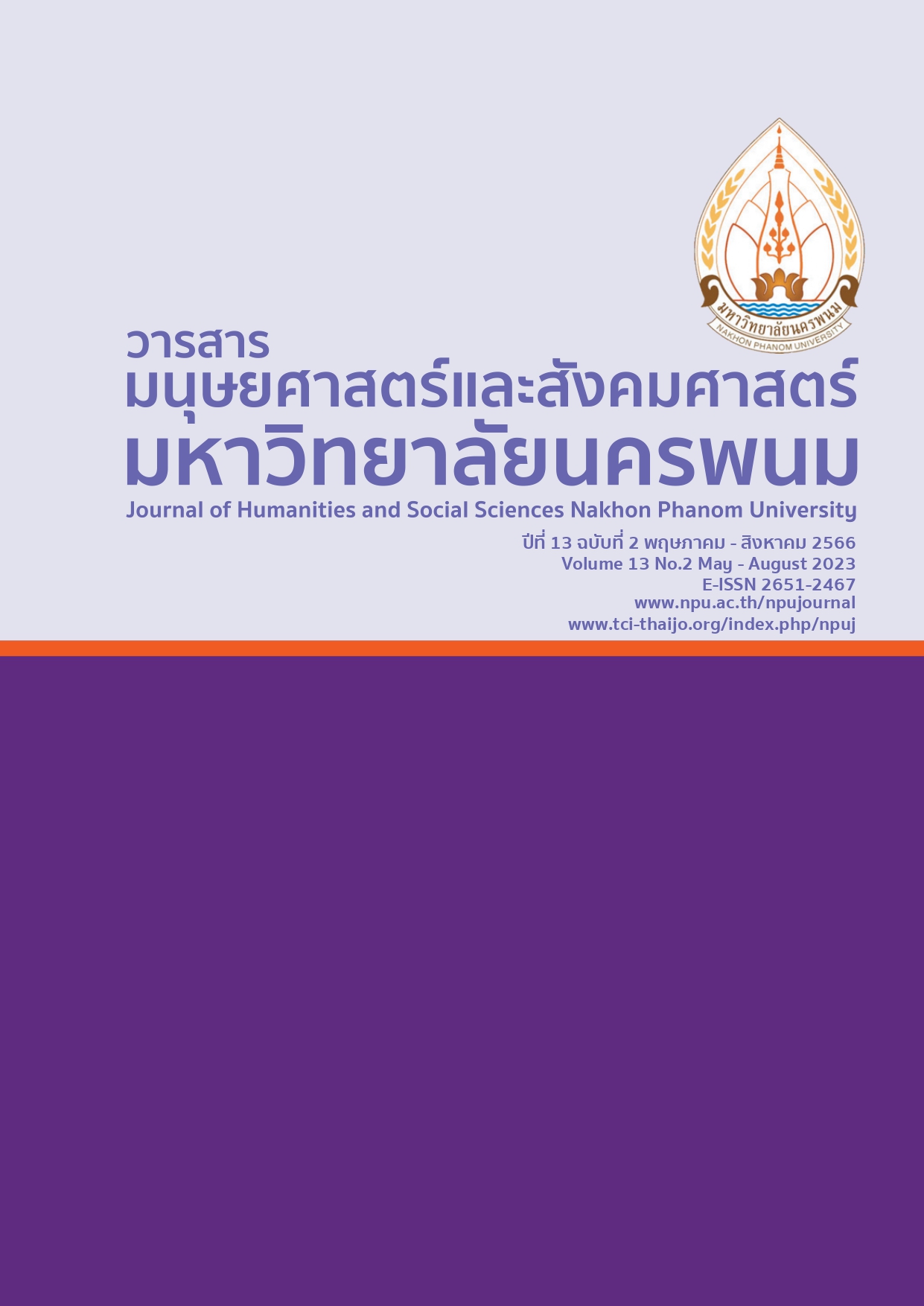The Development of Scientific Creative Thinking Using STEAM Education by Producing Workpieces from Waste Materials
Main Article Content
Abstract
The objectives of this research were to study the efficiency of the learning management plans based on the STEAM education by producing workpieces from waste materials entitled the living of plant for Matthayomsuksa 1 students compares to the 80/80 criteria, and to compare the scientific creative of Matthayomsuksa 1 students before and after being taught by STEAM education learning management by producing workpieces from waste materials entitled the living of plant. This research was an experimental research. The populations were 654 Matthayomsuksa 1 students who were studying at the secondary school under the Office of Secondary Educational Service Area Ofiice Maha Sarakham and the samples were 42 Matthayomsuksa 1/2 students who were studying in the first semester of academic year of 2022. The duration of this research was 12 hours. The research instruments consisted of 2 lesson STEAM education learning management plans by producing workpieces from waste materials, and scientific creative thinking assessment form. The percentage, mean, standard deviation, and t-test were employed to analyze the data. The research results were as follows: 1) the learning management plans based on the STEAM education by producing workpieces from waste materials was effective equivalent to 82.14/81.08 which was along with the defined criteria of 80/80. 2) The scientific creative thinking scores of students that were managed the learning using the STEAM education by producing workpieces from waste materials was significantly higher than before at the .05 level.
Article Details

This work is licensed under a Creative Commons Attribution-NonCommercial-NoDerivatives 4.0 International License.
References
Abhisit, T. (2016). Kitčhakamsongsœ̄mkhwāmkhitsāngsansamrapdeklæyaowachon [Creative activities for children and youth]. Bangkok : Chulalongkorn University Printing House.
Chaopreecha, C. (2019). Kānʻō̜kbǣpkitčhakamkānrīanrūphư̄asāngkhwāmtranakrư̄angsingwǣtlō̜mkhō̜ngnakrīan radapchanmatthayomsưksātō̜ntondōichaithaksakrabūankānthāngwitthayāsātkhansūngphānkānsưksāsư̄aphāthīpenmittō̜singwǣtlō̜m [designing a learning activity to raise awareness of the environment among junior high school students by integrating scientific process skills into the study of eco-friendly clothing]. Journal of Education Khon Kaen University. 42(2),51-64.
Chanintarapum, A. (2020). Kānphatthanārūpbǣpkānrīankānsō̜ntāmnǣokhit STEAM phư̄asongsœ̄mthaksa kānsāngsan Nawatkamthāngthēknōlōyīkhō̜ngnakrīanchanmatthayomsưksā [The Development of Instructional Model Base on STEAM to Enhance Technological Innovation Creativity Skills of Secondary Students]. Nakhon Pathom, Silpakorn University, Thailand.
Dachakup, P. (2014). Kānčhatkān rīanrū nai satawat thī yīsipʻet [Learning Management in the 21st Century]. Bangkok : Chulalongkorn University.
Wandari, G. A., Wijaya, A. F. C. and Agustin, R. R. (2018). The Effect of STEAM-Based Learning on Students' Concept Mastery and Creativity in Learning Light and Optics. Journal of Science Learning. 2(1),26-32.
Henriksen, D. (2014). Full STEAM Ahead: Creativity in Excellent STEM Teaching Practices. The STEAM Journal. 1(2),1-7. https://doi.org/10.5642/steam.20140102.15.
Intavimolsri, S. (2019). Phonkhō̜ngkānchainǣokhi tsatīmasưksāNaiwichach īwa wittha ya ̄thīmītō̜k hwām khitsāngsanthāngwitthayāsātlæphonsumritthāngkānrīankhō̜ngnakrīanchanmatthayomsưksāpīthīSī. [Effects of Using the STEAM Education Approach in Biology on Scientific Creativity and Learning Achievement of Tenth Grade Students]. Journal of Education Studies. 47(2),410-429.
Kitrakarn, P. (2003). Effectiveness index. Mahasarakham: Faculty of Education University Maha Sarakham.
Koocharoenpisal, N., Rasrikrit, A. and Semakoon, S. (2022). Kānphatthanāchutkitkamkānrīanrūtām nǣothān gsate msưksā (STEM EDUCATION) phư̄asongsœ̄mkhwām khitsāngsankhō̜ngnakrīanchanpra thomsư ksāpīthī HāRư̄angkānpraditsing khō̜ngčha ̄kwatdulư̄achai [Development of Learning Activity Packages Based on STEM Education to Improve Creative Thinking for 5th Grade Students on Invention from Waste Materials]. Journal of Silpakorn University. 20(2),196-213.
Kumul, S. (2004). Konlayutkānsō̜nkidsāngsan [Strategy of creative teaching]. Bangkok : Parbpim Limited Partnership.
Orapiriyakul, S. (2019). STEAM EDUCATION: Innovative Education Integrated into Learning Management. Journal of Research and Curriculum Development. 9(1),1-16.
Pattiyathanee, S. (2008). Kānwatphonkānsưksā [Educational measurement (6th ed)]. Banngkok : Prasan Printing.
Pengsawat, W. (2003). Kānwičhainaichanrīan [Classroom research]. Bangkok : Suweeriyasan.
Phengnoi, D. (2020). Kānphatthanā khwāmsāmāt nai kān kǣ panhā yāng sāngsan læ kānsāng phonngā nathāng witthayāsāt khō̜ng nakrīan prathomsưksā pī thī hā dūai kānčhat kitčhakam kānrīanrū tām nǣokhit STEAM Education [The Development of Creative Problem Solving and Scientific Working Creation’s Abilities in Fifth Grade Students By Learning Activities Manage Educationment Based on the Concept of STEAM Education]. Silpakorn University, Nakhon Pathom, Thailand.
Piltz, A. and Sund, R. (1969). Creative Teaching of Sciences in the Elementary School. Boston : Allyn and Bacon.
Puwipadawan, S. (1992). Theknik kān songsœ̄m khwāmkhit sāngsan [Techniques to Encourage creativity thinking]. Bangkok : Thaiwatthanapanich.
Riley, S. (2016). 6 steps to creating a steam classroom, Retrieved September 2020, from https://education closet.com/2016/02/25/6-steps-to-creating-a-steam- centered-classroom/.
Srisaat, B. (2003). Kānphatthanā laksūt [Development of Curriculum]. Bangkok : Suweeriyasan.
Srisaat, B. (2010). K̄nwičhaibư̄angton. [Introduction to Research]. Bangkok : Suweeriyasan.
Suganda, E. et al. (2021). STEAM and Environment on students’ creativethinking skills: A meta-analysis study. Journal of Physic s: Conference Series, 1796(1),012101. https://doi.org/10.10 88/1742-6596/1796/ 1/012101
Tantiranpisan, S. (2002). Sinlapa samrap dek pathommawai [Art for early childhood]. Bangkok : Suweeri yasan.
Taranate, T. (2021). Phonkān čhatkān rīanrū tām nǣo satīma sưksā thī mī tō̜ khwāmkhit sāngsan thāng witthayāsāt læ phon samrit thāngkān rīan witthayāsāt rư̄ang theknōlōyī thāng dīʻenʻē khō̜ng nakrīan chan matthayommasưksā pī thī 4 [The Effects of STEAM Education Approach on Learning Achievement in DNA Technology of 10th Grade Students]. Burapha University, Chonburi, Thailand.
The institute for the promotion of Teaching Science and Technology (IPST). (2017). Māttrathān kānrīanrū læ tūa chī wat klum sāra kānrīanrū witthayāsāt tām laksūt kǣn klāng kānsưksā naphư̄n thān Phutthasakkarāt sō̜ngphanhārō̜ihāsipʻet (chabap prapprung Phō̜.Sō̜. 2560) [The Basic Education Core Curriculum A.D.2008 (Revised edition A.D. 2017) Learning Standards and Indicators of Science major]. Bangkok : IPST.
The institute for the promotion of Teaching Science and Technology (IPST). (2003). Kānčhat sāra kān rīan rū klum sāra kānrīanrū witthayāsāt laksūt kānsưksā naphư̄n thān [The Basic Education Core Curriculum Learning Management of science major]. Bangkok : IPST.
Torrance, E. P. (1962). Guiding Creative Talent. New Jersey : Prentice- Hall.
Triampo, W. (2016). Chutsư̄kānrīanrūwichawitthayāsātsatemsưksā Lēmthī Hā [Science Learning Media Set STEM education Volume 5]. Bangkok : Specialty School located.
Wongpanich, V. (2003). nangsư̄ rīan sāra kānrīanrū phư̄nthān kān ngān ʻāchīp læ theknōlōyī ngān pradit chan matthayommasưksā pī thī nưng-3. [Basic learning textbook Career and technology Invented grades 7-9]. Bangkok : Aksorn Charoen Tat.
Yakman, G. (2008). STEAM Education: an overview of creating a model of integrative education, Retrieved September 2020, from https://www.academia.edu/8113795/STEAM Education_an_overview_of_ creating_a_model_of_integrative_education.


